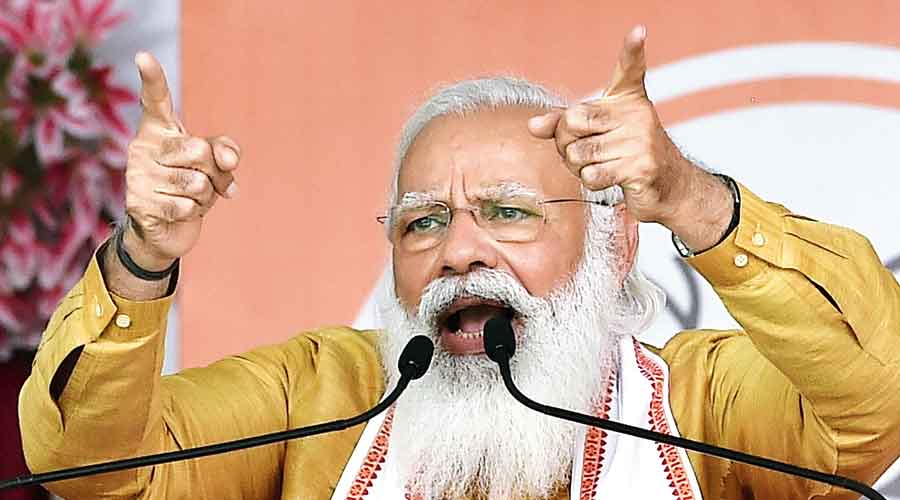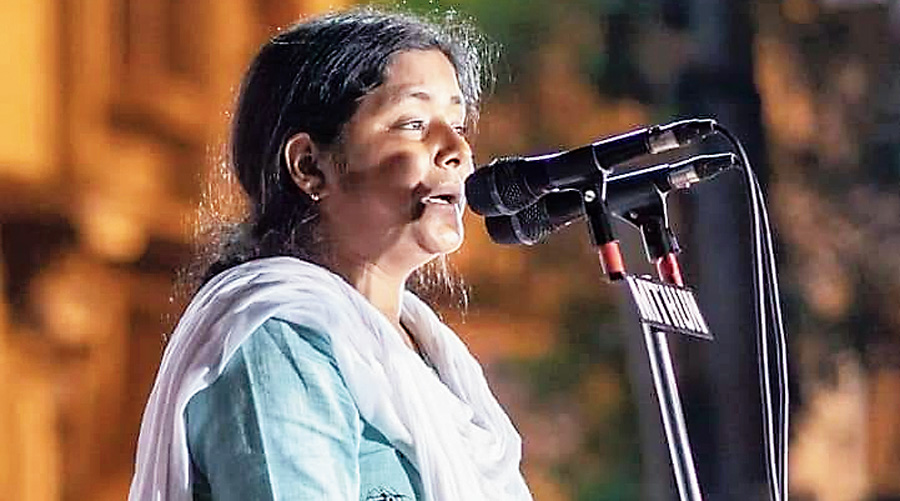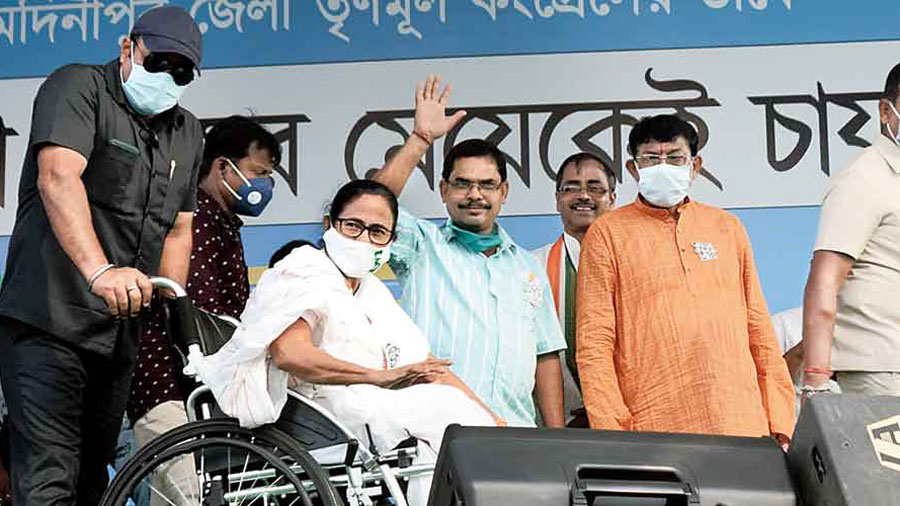A diplomat friend once cited the experience from an earlier era in Bengal to underline just how fragile the concept of national identity can be. “Imagine,” he said, “a person born in Dhaka in, say, 1930. He was Indian till the age of 17. A Pakistani for the next 25 years. And then became a Bangladeshi. He belonged to three nations in less than four decades…”
That era, of course, is long over. But as one travels through parts of Bengal in the midst of yet another landmark election, the most striking aspect is not the much talked of rise of the BJP but a fragility of another kind -- of how utterly fluid political loyalties have become in a state once known for its firm ideological fidelities.

Didi prothom paanch bochor bhalo kaaj korechilen. Kintu taar pore Didir chela chamundara eto cut money khe phele che ki hojom korte parche na. (Didi did a lot of good work in the first five years. But in the second term, her minions siphoned off so much cut money that they are suffering from indigestion).
A voter in Sankrail, Howrah
The other is a sense of déjà vu. The cry of “poriborton”, which rent the air in these parts exactly 10 years ago and catapulted Mamata Banerjee to power, is back in circulation with a gusto. As we crisscross a dozen odd constituencies going to the polls on April 10, the recurring refrain is that there is a “hawa” for the BJP this time because people want “change.”
Sitting in a chai shop near the Sankrail industrial area in Howrah district, Subhendu Mondol is confident that the BJP will win the seat this time because people are unhappy with the corruption of lower level TMC cadres. “Didi prothom paanch bochor bhalo kaaj korechilen. Kintu taar pore Didir chela chamundara eto cut money khe phele che ki hojom korte parche na. (Didi did a lot of good work in the first five years. But in the second term, her minions siphoned off so much cut money that they are suffering from indigestion).”

Prime Minister Narendra Modi addresses an election rally at Contai in East Midnapore on March 24. Telegraph picture
If some cite the “cut money” culture as the reason for their disenchantment with the ruling regime, the youth who throng chai shops, hope that a change of guard in the state might lead to more industry, more jobs. But the much more dominant strain is a generalized desire for “poriborton” for its own sake. Asked to explain the reasons for the “BJP hawa”, the most frequently heard response is: “Poriborton dorkar. Lokera bole aamra chautrish bochor Baam ke dekhechi, dosh bochor Didi ke dekhlam , e baar ekti natun party ke try kori. (We need change. People say we experienced Left rule for 34 years, TMC rule for 10. Let us try a new party).” At a shop in Teghoria, which falls in Sonarpur North constituency, Bhaskar Mondol goes one step further: “Ganatantra te borabor poriborton kora uchit. Tahalei netara kaaj kore. (Change is essential in democracy. Only then are politicians kept on their toes).”
Ironically, even while talking of “poriborton”, the same people express a cynicism about politicians that was rarely heard in Bengal before. It is not just that a host of TMC turncoats are now fighting on a BJP ticket. The cadres have switched sides too. Gaurango Ghosh, a jute mill worker in Ghusuri in Howrah, who is rooting for “change” says in the same breath: “After 2011, all the neighbourhood boys who used to be with CPM joined the TMC. And now all the TMC boys have joined the BJP. Danda ekta, jhanda onek. (There is one flagpole but the flags keep changing).”

Poriborton dorkar. Lokera bole aamra chautrish bochor Baam ke dekhechi, dosh bochor Didi ke dekhlam , e baar ekti natun party ke try kori. (We need change. People say we experienced Left rule for 34 years, TMC rule for 10. Let us try a new party).
An oft-repeated voter sentiment
It is not just the leaders and cadres who have changed flags. Voters have too. In a village under the Uluberia East seat, Malati Barik says her father-in-law was “kottor CPM” and the entire family voted Left for years. But when the TMC took over, they shifted their loyalties. And now they are on the verge of another change. “Jokhon jemon dheu uthbe, tokhon tamon bhaaste hobe (When a wave comes, we have to float with it).”
One well documented reason for the plunge in the Left’s vote share in the 2019 Lok Sabha elections to just 6.34% (which coincided with the BJP’s huge jump to 40.64%) is the large-scale violence against Left supporters in rural Bengal – a phenomenon which began after TMC assumed power but escalated during the panchayat polls of 2018. But “TMC terror” is not the only reason for the shift. A more subtle factor at work today is the emergence of the “floating voter” -- a phenomenon new to Bengal and key to the rise of the BJP.

Left candidate Minakshi Mukherjee at a rally in Jadavpur on April 3. Telegraph picture
With the BJP pulling out all the stops to add Bengal to its long list of electoral conquests, and secular forces fervently hoping that Mamata Banerjee will stave off the challenge, the entire nation’s attention is riveted on this particular election in the state.
The real watershed election, though, was in 2011 when Mamata Banerjee ended the 34-year-run of the Left Front. Much has been written about Bengal’s “cultural exceptionalism”. But on the ground, what made the state different was a stable political grid. The Left had a loyal support base among the peasantry and moffusil intelligentsia; there was a large anti-Left section too who won a fair share of votes even if it was not converted into a winning a great number of seats. The “floating voter” – unallied to any party structure or ideology – was few and far between.

Danda ekta, jhanda onek (There is one flagpole but the flags keep changing).
A jute mill worker in Ghusuri, Howrah
In 2011, when Mamata Banerjee defeated the Left behemoth following peasant agitations against land acquisition in Singur and Nandigram, that grid was smashed completely. Over the last decade, the mass base of the Left -- which is distinct from cadre strength – scattered. The depoliticized floating voter came into being. And like in other parts of India, the main aim of the floating voter is to go with the “winning side,” whichever party that may be.
The BJP’s attempt at communal polarization is certainly one factor behind its expansion in Bengal and this is evident from the fact that everyone who talks of “poriborton” today belongs to the majority community. But a more important factor has been its ability to take advantage of the anti-incumbency sentiments that has grown against the TMC. And the most important factor attracting a large swathe of floating voters is that it has created the impression of being a winning party.

Jokhon jemon dheu uthbe, tokhon tamon bhaaste hobe (When a wave comes, we have to float with it).
A voter of Uluberia East constituency
An eight-phase election spread over a month has been carefully crafted in a way that the BJP starts in its strongholds, and with each passing phase, spreads the word that it is on a winning spree. The CPM-led secular front may take part of the anti-incumbency vote in seats where it has fielded strong candidates – such as Jadavpur where the CPM’s sitting MLA Sujan Chakraborty remains popular. But as a “new party” on the Bengal scene, the BJP could be a far bigger beneficiary of the “poriborton” sentiment being voiced across the state.
What is striking though is that while “poriborton” is on many a voter’s lips, no one adds Narendra Modi’s prefix of “ashol (real)” to it. And though his posters are everywhere, hardly anyone takes the name of Modi, focusing instead on the need for change.
Both hard core supporters of the BJP as well as its fervent opponents regard the 2021 assembly elections as momentous, with far reaching consequences for both the state and the country. The voters on the ground seem curiously matter of fact in comparison. With the experience of ending the once invincible Left ten years ago, they are almost cocky in their conviction that change will be the new constant. Unmoved by fears of what “change” may actually mean, a frequent response is: “Bhalo na hole, aabar bodle debo. (If it is not good, we will get rid of them too).”
Naïve as the sentiment maybe, it does have a reassuring ring to it…










